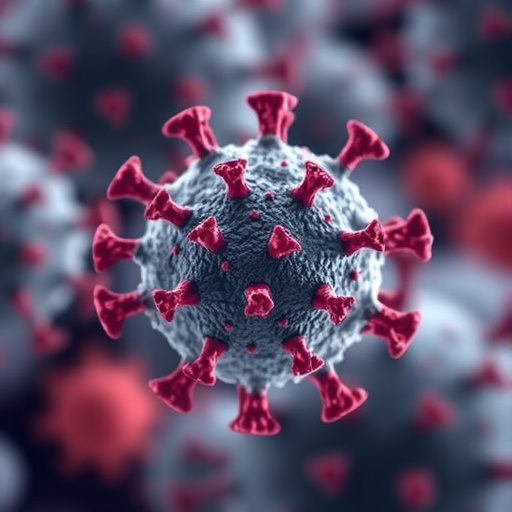
In the relentless global pursuit to curb the COVID-19 pandemic, researchers have made a compelling breakthrough by repurposing an old antiparasitic drug, niclosamide, into a novel nanohybrid formulation. This innovative approach, detailed in a recent clinical trial published in Nature Communications, reveals promising therapeutic potential for patients with mild to moderate COVID-19. The study represents a significant stride toward expanding the arsenal of effective treatments against SARS-CoV-2, the virus responsible for the disease.
Niclosamide, a long-established anthelmintic agent primarily used to eliminate tapeworm infections, has gained considerable attention in recent years for its broad-spectrum antiviral properties. Despite its well-documented safety profile, niclosamide’s clinical application against respiratory viruses—including SARS-CoV-2—has been hamstrung by poor aqueous solubility and limited bioavailability. Addressing this challenge, researchers engineered a nanohybrid formulation designed to enhance the drug’s pharmacokinetic properties, thereby optimizing its delivery and therapeutic efficacy in COVID-19 patients.
The clinical trial, notable for its rigorous randomized, double-blind, placebo-controlled design, enlisted participants diagnosed with mild to moderate COVID-19. This structure minimizes bias and strengthens the validity of the findings. Over the course of the investigation, subjects received either the niclosamide nanohybrid or a placebo, with meticulous monitoring of virological and clinical endpoints. The goal was to evaluate whether this novel formulation could significantly reduce viral loads and ameliorate symptom severity compared to standard care.
.adsslot_q97xDjLH2v{width:728px !important;height:90px !important;}
@media(max-width:1199px){ .adsslot_q97xDjLH2v{width:468px !important;height:60px !important;}
}
@media(max-width:767px){ .adsslot_q97xDjLH2v{width:320px !important;height:50px !important;}
}
ADVERTISEMENT
Initial results from the study are striking. Patients administered niclosamide nanohybrid exhibited a marked reduction in viral RNA levels, as confirmed by quantitative PCR analyses, suggesting a potent antiviral effect in vivo. Moreover, this viral suppression was accompanied by faster symptom resolution and decreased progression to severe illness. These outcomes are particularly encouraging, as they underscore the formulation’s capacity not only to inhibit viral replication but also to positively influence clinical trajectories in affected individuals.
Beyond the clear antiviral advantages, the trial also highlighted the formulation’s favorable safety profile. Throughout the treatment duration, adverse events were minimal and comparable between the niclosamide and placebo groups. This finding reinforces niclosamide’s long-standing reputation as a safe therapeutic compound and suggests that its nanohybrid variant does not introduce unforeseen toxicities—a critical consideration for broad clinical implementation.
The mechanistic underpinnings of niclosamide’s effect on SARS-CoV-2 relate to its multifaceted modes of action. Historically, niclosamide has been recognized for disrupting mitochondrial oxidative phosphorylation and modulating cellular pH, effects that are deleterious to viral replication cycles. In the context of COVID-19, niclosamide appears to impede viral entry or replication by altering endosomal pH and interfering with key signaling pathways exploited by SARS-CoV-2. The nanoformulation likely amplifies these mechanisms by ensuring enhanced drug concentrations at the site of infection.
This study’s innovative nanohybrid approach employs state-of-the-art nanotechnology to overcome solubility constraints, a common hurdle in drug delivery. By embedding niclosamide within a nanostructured matrix, researchers achieved sustained release kinetics and improved dissolution rates. This strategic enhancement translates to consistent systemic exposure, vital for therapeutic action against an aggressive viral pathogen. Such advancements exemplify the fusion of pharmaceutical formulation science and infectious disease therapeutics.
Importantly, this trial’s findings resonate within the broader scientific and medical communities grappling with the challenges posed by emerging viral variants. As new strains of SARS-CoV-2 continue to evolve, maintaining effective treatment options remains a priority. Niclosamide’s mechanism, targeting host cellular processes rather than viral proteins directly, may confer a resilience against variant-mediated drug resistance, positioning it as a valuable candidate for future therapeutic regimens.
The implications extend beyond individual patient outcomes. Effective antiviral therapy at early stages can drastically reduce viral shedding and transmission potential within communities. By accelerating viral clearance, niclosamide nanohybrids could contribute to lowering the overall viral burden on healthcare systems and curtail the pandemic’s spread. Such public health benefits underscore the significant societal impact of this pharmaceutical innovation.
Furthermore, the convenience of repurposing niclosamide simplifies regulatory pathways, potentially expediting its availability for clinical use. With a well-characterized safety profile and decades of prior human use, niclosamide’s repositioning satisfies urgent demands for accessible and affordable COVID-19 treatments, especially in low-resource settings where vaccine access and advanced therapeutics remain limited.
Nevertheless, the authors acknowledge the necessity for larger-scale trials to confirm and expand upon these preliminary findings. Future studies should encompass diverse patient populations, including those with severe disease and varying comorbidities, to elucidate the full therapeutic spectrum of niclosamide nanohybrids. Additionally, exploring synergistic effects with existing antiviral agents or immunomodulators may open new avenues for combination therapies.
Equally critical is the continued examination of pharmacodynamics and optimal dosing strategies, ensuring maximal efficacy with minimal toxicity. The nanohybrid platform’s versatility offers a promising template for designing further improved niclosamide analogs or other antiviral compounds, adapting rapidly to the shifting landscape of COVID-19 therapeutics.
In a scientific era driven by urgency and innovation, this trial exemplifies how interdisciplinary collaboration—integrating nanotechnology, virology, and clinical pharmacology—can spearhead novel solutions to global health crises. The adoption of such transformative strategies heralds a paradigm shift in drug development and pandemic preparedness alike.
As the world continues to grapple with COVID-19’s enduring impact, studies like this illuminate pathways toward managing viral diseases through smart drug repurposing and cutting-edge delivery systems. The niclosamide nanohybrid emerges as a beacon of hope, holding potential not only to improve patient outcomes but also to fortify our collective defenses against future viral pathogens.
Subject of Research: Treatment of patients with mild to moderate COVID-19 using a niclosamide nanohybrid formulation.
Article Title: A randomized, double-blind, placebo-controlled trial of niclosamide nanohybrid for the treatment of patients with mild to moderate COVID-19.
Article References:
Kim, J.H., Kym, S., Kim, S.W. et al. A randomized, double-blind, placebo-controlled trial of niclosamide nanohybrid for the treatment of patients with mild to moderate COVID-19. Nat Commun 16, 7084 (2025). https://doi.org/10.1038/s41467-025-62423-4
Image Credits: AI Generated
Tags: clinical trial methodologiesCOVID-19 treatment innovationsenhancing pharmacokinetic propertiesimproving drug bioavailabilitymild to moderate COVID-19 patientsniclosamide nanohybrid formulationrandomized double-blind studiesrepurposing antiparasitic drugssafety profile of niclosamideSARS-CoV-2 antiviral propertiestherapeutic efficacy of nanohybridsvirological monitoring in clinical trials





